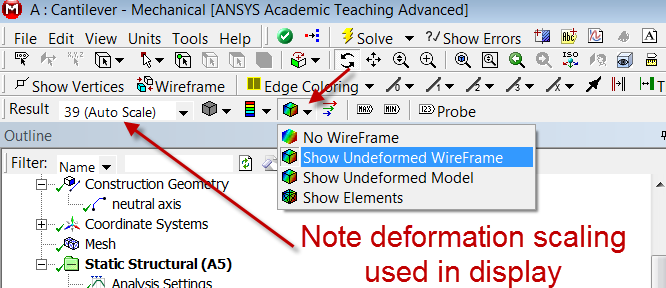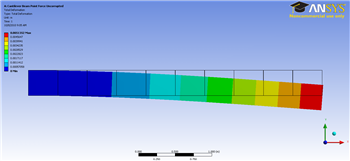| Include Page | ||||
|---|---|---|---|---|
|
| Include Page | ||||
|---|---|---|---|---|
|
Step 6: Numerical Results
...
First, examine the total deformation by clicking on the Total Deformation object in the tree. Turn on the Undeformed Wireframe as shown below.
With 10 line elements, you should see the following output for the total deformation.
| newwindow | ||||
|---|---|---|---|---|
| ||||
https://confluence.cornell.edu/download/attachments/125812731/10ElemTotDefCornellian_full.png |
If you turn off View > Thick Shells and Beams, you will see the deformation of the line elements. The 3D beam view is constructed from this. The maximum deformation is 0.0051 m which matches the hand-calculation value from the Pre-Analysis.
When ANSYS displays the beam deformation, it just connects the displacements at nodes by straight lines. The display ignores the fact that the we also have the slope at the nodes. So you'll see an unphysical-looking jagged kinked line in the deformation display. This is a shortcoming of the display, not of the underlying beam element formulation. You'll see the displayed deformed shape getting smoother as you refine the mesh.
The beam deformation can be animated by clicking on the play button, , which is located underneath the beam deformation results. This will interpolate between the initial undeformed and final deformed configurations.
Maximum Bending Stress
In order to examine the maximum bending stress first expand the Beam Tool folder, , which is located under "Solution(A6)". Next, click on the Maximum Bending Stress button, .
Note that in this display, ANSYS shows the same value across the cross-section. This visualization is misleading. The maximum bending stress occurs only at the top fiber. The value that ANSYS reports is 4.635 MPa which matches the value from the Pre-Analysis exactly.
...
To view the bending moment along the beam, click Total Bending Moment in the Outline window. You should see the following in the graphics window.
| newwindow | ||||
|---|---|---|---|---|
| ||||
https://confluence.cornell.edu/download/attachments/125812731/BendingMoment.png?version=1&modificationDate=1316567309000 |
| newwindow | ||||
|---|---|---|---|---|
| ||||
https://confluence.cornell.edu/download/attachments/125812731/Graph.png?version=1&modificationDate=1316567430000 |
| Latex |
|---|
$
M = F \times d = (8000 N) \times (4 m) = 32000 \mbox{ Nm}
$
|
...
Go to Step 7: Verification & Validation
...
 Sign-up for free online course on ANSYS simulations!
Sign-up for free online course on ANSYS simulations!







